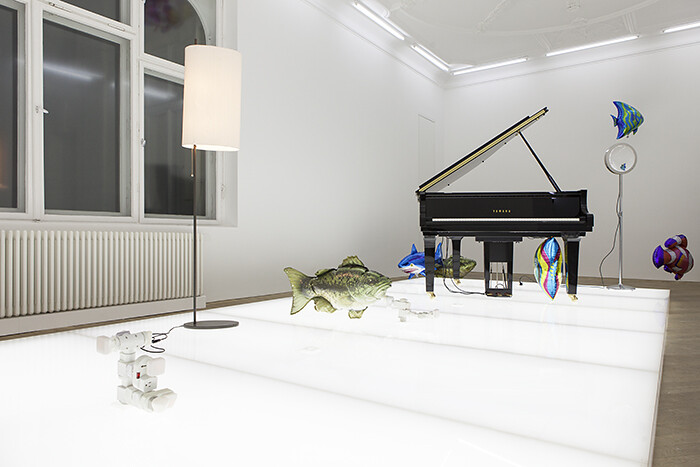What do things want? The notion of animism is correlated with the problem of agency—who or what can be said to have volition. According to Norbert Wiener, “our consciousness of will in another person is just that sense of encountering a self-maintaining mechanism aiding or opposing our actions.”1 One can also define animism as a transfer of volition from the animate to the inanimate, through which life and liveliness shift from increasingly inert human bodies to increasingly energetic and inventive things.2
Be it because of changes in pressure or temperature, the fish-shaped balloons in Philippe Parreno’s installation Quasi Objects: My Room is a Fish Bowl, AC/DC Snakes, Happy Ending, Il Tempo del Postino, Opalescent acrylic glass podium, Disklavier Piano (2014)—currently on view as a part of Parreno’s “quasi-objects” at Esther Schipper in Berlin—clearly want to escape. Sharks are the cheekiest: on the opening evening, one tried to follow us out, but was promptly captured by the doorman—that was his function, in fact, to make sure no fish would escape the premises. Another was found at the stairwell ceiling, apparently disillusioned with life on the run. The angelfish and the odd carp seemed to better conform, but maybe I am stereotyping.
“Quasi-objects” is a term coined by French philosopher Michel Serres, which aptly applies to balloon fish. Quasi-objects are objects endowed with a quasi-agency. Serres offers the example of a football, whose physical properties frame the action inside a stadium: “playing is nothing else but making oneself the attribute of the ball as a substance.” Inside the gallery, the floating fish are juxtaposed against an automated musical score based on an excerpt from Franz Liszt’s Nuages Gris (1881) played on a grand piano. Using a timing synchronization system, Liszt’s composition is continuously altered by two cellular automata3—John Horton Conway’s Game of Life and Brian Silverman’s Brian’s Brain—which also command a copious amount of flickering light bulbs, Marquee (cluster) (2014). The effect is an Amélie Poulainesque cacophony mixing highbrow and infantile elements. Quasi-objects are said to shape collective agency, but what of their agency as a collective?
We are at the verge of a second industrial revolution: the Internet of Things (IoT) will equip daily objects and household appliances with virtual representations linked together in an internet-like structure. By 2020, there will be nearly 26 billion devices on the IoT—that is, 26 billion talking toasters, probably equipped with endearing interfaces. In a sense one could see Parreno’s quasi-objects as unwittingly announcing this new ontology, inasmuch as Relational Aesthetics—a discourse with which Parreno has been associated—anticipated social media. And yet, what Vivian Sobchack called the dialectical entanglement between automation and animation4 has been apparent since the beginning of industrial culture, and in a way, all commodities are objects animated by affects.
Contrasting the cheerfulness of “quasi-objects,” the object-oriented ontology of Parreno’s twin Berlin exhibition “How Can We Tell The Dancers from the Dance” at the Schinkel Pavillon acquires a more ominous tone. Circling an empty dance floor haunted by the muffled sound of absent performers—performing excerpts of Merce Cunningham’s Roaratorio, Suite for Five, XOVER, RainForest, and Duets—one finds a concave wall relentlessly rotating around a central axis. Unlike the fish, which flee before the visitors, the white mass remains unyielding.
In what one can only call a freaky coincidence, during the week of Parreno’s opening, Berlin celebrated the 25-year anniversary of the fall of its Wall. Balloons where placed throughout the city marking the length and height of the now absent barrier, all 8,000 of which were released to symbolize the lifting of the blockage. Yet whatever it is that a wall wants, turning into a balloon is certainly not it. In Parreno’s twin endeavour, fish and wall remain, much like East and West or pristine style and fun-fair aesthetics, the “torn halves of an integral freedom, to which however they do not add up.”5
See Peter Galison, “The Ontology of the Enemy: Norbert Wiener and the Cybernetic Vision,” Critical Inquiry, vol 21, no. 1 (Autumn 1994): 228–266.
I am paraphrasing Vivian Sobchack, “Animation and automation, or, the incredible effortfulness of being,” published in Screen, vol 50, no. 4 (Winter 2009), 375.
Cellular automata are grids of cells to each of which a finite number of states is assigned (for instance, on or off), along with a set of rules for the cells to follow. The combined action of all cells creates manifold configurations. Cellular automata were originally invented by Stanislaw Ulam and John von Neumann but only became widely known after British mathematician John Horton Conway devised his highly popular Game of Life in 1970.
Sobchack, id.
Theodor Adorno referring to high and lowbrow culture in his correspondence with Walter Benjamin, 18 March 1936, quoted in New Left Review, vol 11 (1973), 166.








